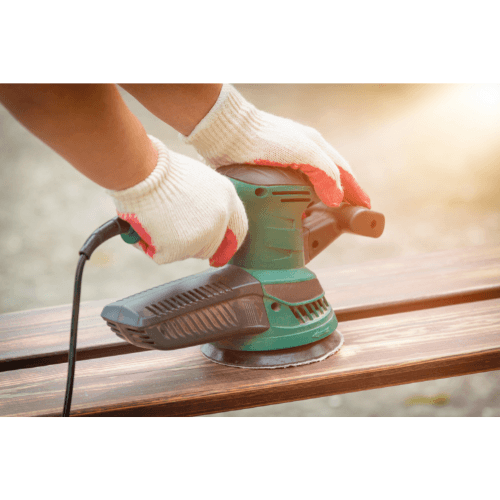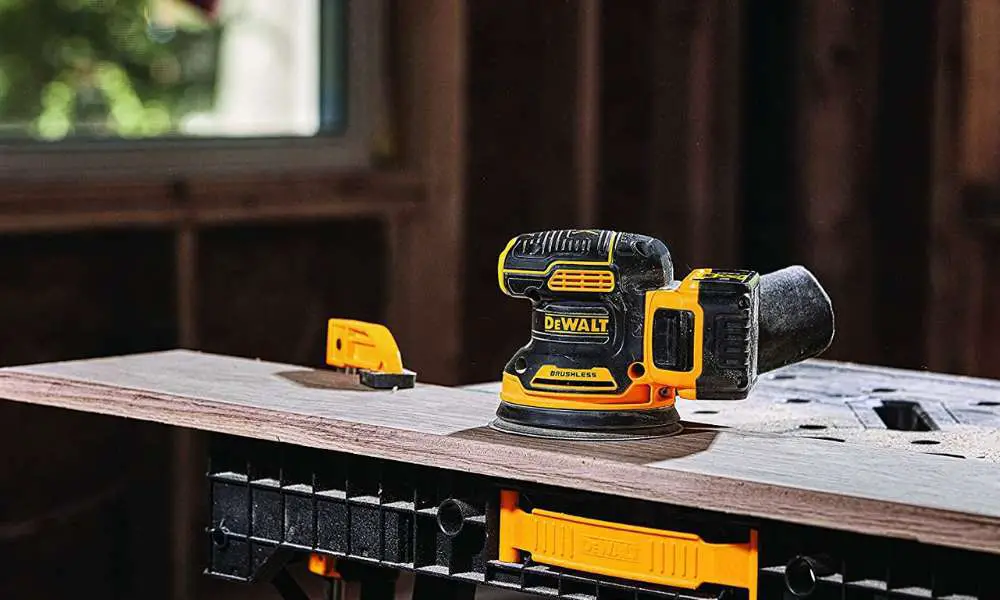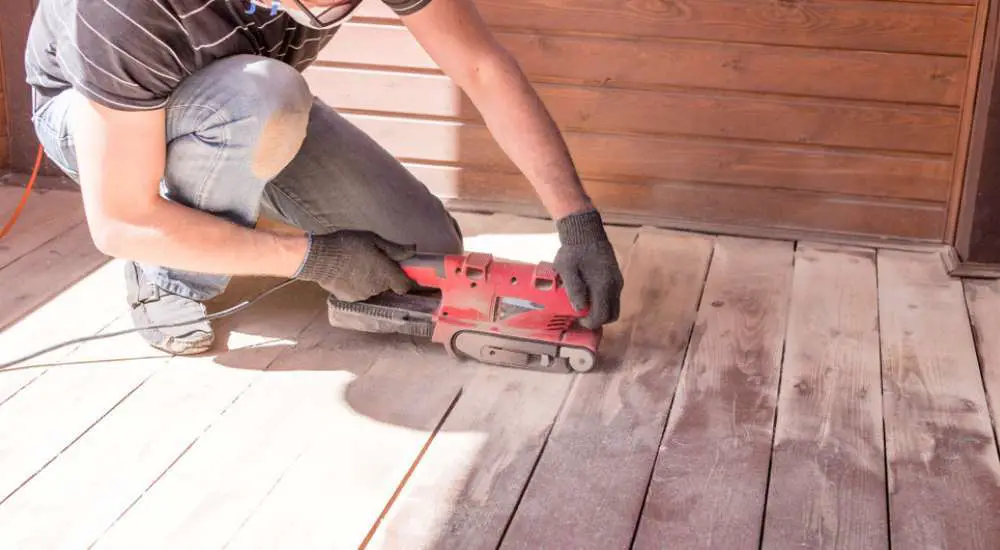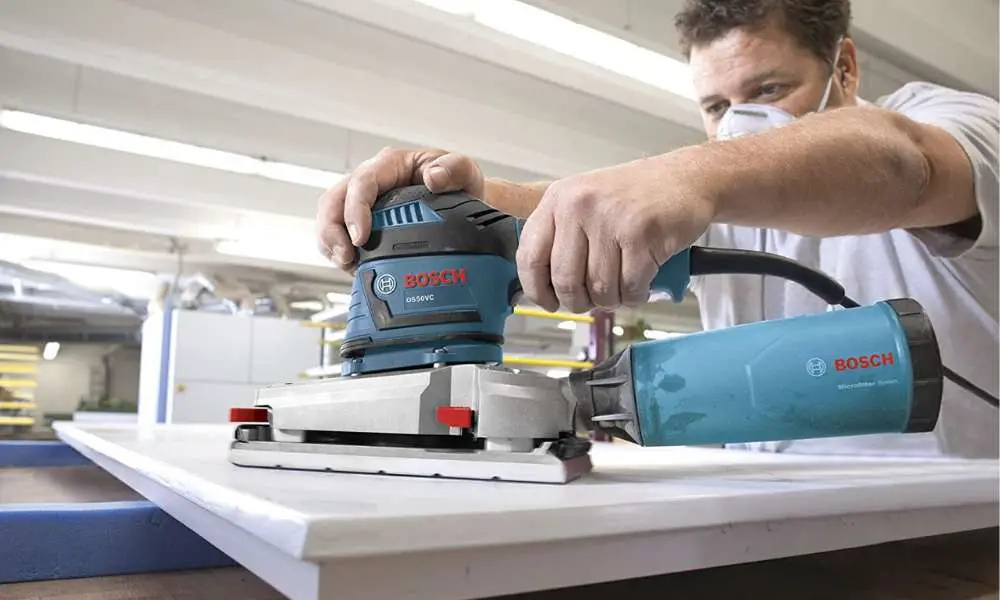In the world of woodworking and home improvement, having the right tools is essential for achieving a smooth, professional finish. One such tool that has revolutionized the process of sanding is the random orbital sander. Known for its versatility and efficiency, this power tool has become a staple in both professional workshops and home garages. Its unique design and functionality set it apart from traditional sanding methods, making it a topic of interest for both seasoned professionals and DIY enthusiasts.
Understanding how does random orbital sander works is key to unlocking its full potential. The keyword here is ‘random orbital’, a term that refers to the distinctive motion of the sander. Unlike regular sanders that move in a fixed pattern, random orbital sanders combine two distinct movements, creating a random pattern. This not only ensures a more uniform sanding process but also significantly reduces the chances of leaving swirl marks on the workpiece.
So, how exactly does a random orbital sander achieve this? The secret lies in its internal mechanism. A random orbital sander operates through a small, circular pad that spins in a circular motion (like an orbital sander) while also moving in an elliptical pattern. This dual action – spinning and oscillating – means that no part of the abrasive material travels the same path twice on the workpiece. As a result, it produces a much smoother surface without the tell-tale swirls that other sanders might leave behind. This intricate motion makes the random orbital sander an invaluable tool for anyone seeking a flawless finish on their projects.
A random orbital sander is a popular power tool used to achieve a smooth, swirl-free finish on various surfaces, including wood, plastic, and metal. This versatile device operates by moving the sanding pad in irregular, overlapping circles, which helps prevent the creation of noticeable patterns on the sanded surface. Thanks to its unique motion, a random orbital sander is ideal for both aggressive material removal and delicate finishing tasks.
The effectiveness of random orbital sanders lies in their innovative design that combines rotational and orbital movement. The sanding pad rotates and moves in an elliptical pattern, ensuring that no part of the pad crosses the same point on the surface more than once. This mechanism guarantees a smooth and consistent finish without any swirl marks, which are often common with other types of sanders.
Contents
- 1 Basic Principles
- 2 Design and Construction
- 3 Types of Random Orbital Sanders
- 4 Sanding Operation
- 5 Safety and Maintenance
- 6 Applications and Material Compatibility
- 7 Frequently Asked Questions – How does random orbital sander work
- 7.1 What are the main advantages of using a random orbital sander over other types?
- 7.2 Can you detail how to properly use a random orbital sander on hardwood floors?
- 7.3 What is the best technique for removing paint with a random orbital sander?
- 7.4 How do you apply the correct pressure when operating a random orbital sander?
- 7.5 What makes the motion of a random orbital sander different from a regular orbital sander?
- 7.6 Which features should you look for when reading reviews on random orbital sanders?
- 8 Footnotes
Key Takeaways
- Random orbital sanders provide a swirl-free finish on various surfaces
- The tool operates with a unique combination of rotational and orbital movement
- This versatile power tool is suitable for aggressive material removal and delicate finishing tasks
Basic Principles

Orbital Motion
A random orbital sander works by combining two distinct motions which enable a smooth, swirl-free finish on surfaces. The orbital motion involves the sanding pad moving in a tight circular pattern, while simultaneously rotating around its axis. This unique motion ensures scratches from sanding are dispersed in varying directions, making them virtually invisible. The random nature of the tool’s movement prevents the formation of noticeable swirls and marks on the surface that you are working on1.
Variable Speed Control
Another essential feature of a random orbital sander is variable speed control. This allows the user to adjust the speed of rotation to suit the specific material and project requirements. Lower speeds can be used for delicate tasks or when working on softer materials, while higher speeds are suitable for more aggressive sanding or tougher surfaces2. Being able to control the speed not only improves the quality of the finish but also provides users with more control and adaptability during the sanding process.
In summary, a random orbital sander relies on uniquely combined movements and adjustable speed control to deliver a high-quality, swirl-free finish on various types of surfaces, including wood, metal, and plastic.
Design and Construction
Motor and Drive Assembly
Random orbital sanders are powered by an electric motor, which spins the sanding pad at high speeds. This action is supported by a drive assembly that includes a gear system and an eccentric mechanism. The combination of these components allows the sander to cover both rotational and oscillational movement (source).
Sanding Pad Mechanism
The sanding pad (usually 5 or 6 inches in diameter) is designed to move in random orbits, which helps eliminate swirls and scratches on the work surface. It consists of a backing plate made of hard plastic, attached to a soft or medium foam layer. The sanding discs attach to the pad via hook and loop (Velcro) or a pressure-sensitive adhesive (source).
Dust Collection System
A critical aspect of random orbital sanders is their dust collection system. Most models have built-in dust control, which consists of a dust port connected to a vacuum hose or a dust bag. This prevents dust and debris from being released into the air and improves the workspace’s overall cleanliness (source).
Ergonomics and Durability
Random orbital sanders come in various configurations, such as palm-sized, right-angle, and in-line models, to suit different user preferences and workload requirements. Ergonomics play a vital role in the ease of use and control of these tools. The sander’s body is typically designed with a comfortable grip and minimal vibration, ensuring longer usage without fatigue. Quality models also prioritize durability, incorporating sturdy materials and efficient motor cooling systems (source).
Types of Random Orbital Sanders
There are several types of random orbital sanders available on the market, each with its unique features and advantages. In this section, we will briefly explore electric and pneumatic random orbital sanders.
Electric Random Orbital Sanders
Electric random orbital sanders are the most popular type of sanders mainly because of their versatility and ease of use. They are powered by an electric motor, which drives a sanding pad in a random orbit to achieve a smooth finish on surfaces. Electric random orbital sanders come in two main categories: corded and cordless.
Corded: Corded electric sanders are the most common type. They require a constant power source to operate and typically offer consistent performance and power. Corded sanders are ideal for indoor projects or where a reliable power source is available. They have the advantage of not requiring battery replacements or recharges.
Cordless: Cordless electric sanders run on rechargeable batteries, which makes them highly portable. They are perfect for outdoor projects or locations where power outlets are not available. However, battery life can be limited, and you may need to carry extra batteries for longer projects.
Pneumatic Random Orbital Sanders
Pneumatic random orbital sanders, also known as air-powered sanders, use compressed air as their power source. They are typically lighter and more powerful than electric random orbital sanders. Pneumatic sanders require an air compressor to operate, which can be a disadvantage if portability and ease of use are important factors.
Pros:
- Lightweight
- Powerful and consistent performance
- Less likely to overheat with extended use
Cons:
- Requires an air compressor
- Can be noisy
- Less portable due to reliance on the air compressor
Corded vs Cordless
When deciding between a corded and cordless random orbital sander, you should consider factors such as power, portability, and convenience.
| Feature | Corded | Cordless |
|---|---|---|
| Power | Consistent and reliable | Depends on battery life and capacity |
| Portability | Limited by power cord | High, no power cord required |
| Convenience | Requires a power source; no batteries | Battery-dependent; no power source |
In conclusion, the type of random orbital sander you choose should depend on the specific requirements of your projects, as well as your preferences for power, portability, and convenience. By carefully considering these factors, you can make an informed decision about the best random orbital sander for your needs.
Sanding Operation
Pad and Abrasive Installation
To start using a random orbital sander, it’s crucial to install the sanding pad and abrasive correctly. First, ensure the sander is switched off and unplugged. Then, align the holes of the abrasive disc with the sanding pad’s holes and press it into place. Most sanders use hook and loop systems, so this process is simple and requires little pressure. With the abrasive properly attached, you’re ready for surface preparation.
Surface Preparation
Before sanding, take a moment to inspect the workpiece and remove any protruding nails, staples, or other metal objects that could damage the sander or the abrasive. It’s also a good idea to clean the surface from dust, grease, and other contaminants. Wiping it down with a lint-free cloth or using a vacuum cleaner can help. Proper surface preparation ensures a smooth and even finish.
Sanding Technique
- Dress for the job: Wear safety glasses, a mask, and appropriate clothing to protect yourself from dust and debris.
- Start with the right sandpaper: Choose the appropriate grit size for your project. Lower grit sizes (e.g., 60) are more aggressive and remove material faster, while higher grit sizes (e.g., 220) produce a smoother finish.
- Place the sander on the workpiece before starting: As recommended by the Family Handyman, place the sander on the work surface before turning it on to avoid deep scratches.
- Apply even pressure: Let the sanding pad’s weight do the work and avoid pushing down on the sander. Too much pressure might create sanding marks or swirl patterns.
- Move the sander consistently: Sand with a consistent speed and motion, overlapping each pass slightly. This ensures even sanding and reduces the risk of swirl marks.
- Check your progress: Frequently stop the sander and check your work to avoid removing too much material or creating uneven surfaces.
- Switch to finer grits: As the workpiece’s surface becomes smoother, gradually switch to finer grit sandpapers to achieve the desired finish.
By following the steps mentioned in these subsections, the sanding operation can be executed effectively using a random orbital sander. Always follow the manufacturer’s instructions for your specific sander model to ensure proper use and safety.
Safety and Maintenance
Operating Safety Tips
When using a random orbital sander, it is essential to follow these safety tips to prevent injury:
- Dress for the job: Wear safety glasses, a dust mask, and ear protection to avoid irritation or injury while sanding.
- Use both hands: Operate the sander with both hands for better control and stability.
- Unplug before changing sandpaper: Always unplug your sander before attaching a new sandpaper disc to prevent accidental activation source.
- Inspect your workpiece: Check for nails, staples, or other foreign objects that could damage the sander or cause injury.
- Smooth start: Allow the sander to reach full speed before touching the surface to prevent gouging the material.
Routine Maintenance
Regular maintenance is crucial to ensuring the random orbital sander’s longevity and functionality. Follow these steps for effective upkeep:
- Clean the sander: Remove dust and debris from the sander’s body, sanding pad, and vents with a soft brush or compressed air after each use.
- Check the sanding pad: Inspect the sanding pad for wear and replace it if needed. Pads with torn hook-and-loop fasteners will not hold sandpaper discs securely source.
- Inspect bearings and brushes: Visually inspect the motor brushes and bearings regularly. Replace them when they show signs of wear.
- Lubricate: Periodically lubricate moving parts, such as gears and bearings, with a high-quality lubricant to ensure smooth operation.
- Store properly: Store your sander in a dry and clean environment to prevent rusting and dust buildup.
Following these safety and maintenance tips will help ensure a safe and productive experience with your random orbital sander.
Applications and Material Compatibility

Woodworking Applications
Random orbital sanders are widely used in woodworking projects due to their efficiency in providing smooth finishes. The elliptical or ovular pattern of the sanding pad ensures that the wood surface remains free from visible swirl marks. These tools are especially beneficial in:
- Furniture making: Helps in achieving smooth surfaces before applying paint or finish.
- Cabinet smoothing: Ensures evenness on doors and frames for better appearance and function.
- General carpentry: Allows for precise results in various woodworking projects.
Metal and Plastic Finishing
Another common application of random orbital sanders is metal and plastic finishing. The combination of rotary and orbital movements provides efficient sanding results on these materials as well. Key applications of these tools on metals and plastics include:
- Automotive bodywork: Helps in removing paint, scratches, and dents before repainting.
- Deburring: Assists in eliminating rough edges or projections after cutting or machining processes.
- Surface preparation: Ensures a uniform surface for proper adhesion of coatings or sealants.
Paint Removal
Random orbital sanders are also effective in paint removal tasks on various surfaces like wood, metal, or plastic. Their random orbits reduce the risk of damaging the underlying material while stripping away paint layers. This makes them a valuable tool for tasks such as:
- Refinishing furniture: Enables efficient paint removal from tables, chairs, or dressers.
- Restoring wooden decks: Aids in quick and thorough preparation for staining or painting.
- Preparing metal objects for repainting: Offers effective stripping of old paint on cars, tools, or appliances.
Frequently Asked Questions – How does random orbital sander work
What are the main advantages of using a random orbital sander over other types?
Random orbital sanders provide a smooth, swirl-free finish which is often preferred over regular orbital sanders. Their unique motion, combining both spinning and oscillating, ensures that scratches intersect and become virtually invisible. They are versatile and suitable for a variety of sanding tasks, from wood to metal and even paint removal source.
Can you detail how to properly use a random orbital sander on hardwood floors?
To use a random orbital sander on hardwood floors, first ensure proper safety gear is worn, such as eye protection and a dust mask. Start by selecting the appropriate sandpaper grit and attach it to the sander. Begin sanding along the wood grain in a consistent and even motion, moving back and forth at a steady pace. Be mindful not to apply too much pressure, as it may cause the sander to leave marks or damage the floor. Finally, after sanding, vacuum the dust and change to a finer grit sandpaper to repeat the process for a smooth finish source.
What is the best technique for removing paint with a random orbital sander?
To remove paint with a random orbital sander, begin by using a coarse grit sandpaper (60-80 grit) to remove the bulk of the paint. Apply light pressure and use a slow, steady motion, allowing the machine to do the work. After the majority of paint has been removed, switch to a medium grit sandpaper (120-150 grit) to further smooth the surface. Finish by using a fine grit sandpaper (180-220 grit) for an even and paint-free finish source.
How do you apply the correct pressure when operating a random orbital sander?
When using a random orbital sander, it’s crucial to apply only light pressure, allowing the sander to maintain proper contact with the surface. Too much pressure may cause uneven sanding, scratches, or potential damage to both the tool and workpiece. The weight of the sander itself is often enough pressure, so simply guide it with a gentle hand and let the machine do the work source.
What makes the motion of a random orbital sander different from a regular orbital sander?
The motion of a random orbital sander is different from a regular orbital sander due to its combined spinning and oscillating movement. A random orbital sander’s pad rotates in a circular pattern while simultaneously oscillating in small, tight orbits. This results in a random pattern of scratches, which minimizes visible swirl marks and ensures a smoother finish source.
Which features should you look for when reading reviews on random orbital sanders?
When reading reviews for random orbital sanders, some key features to consider include power (corded or cordless options), grip style (palm grip or straight handle), and variable speed controls. Additionally, look for dust collection systems, ease of changing sandpapers, and overall build quality and durability. User experiences and review ratings, along with the compatibility of the sander with various sanding tasks, provide valuable insight into the product’s functionality and value source.




Leave a Reply